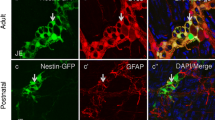Abstract
To investigate relationships between changes in the 3-dimensional structure of the myenteric plexus and the time at which functional movement of intestine begins in mammalian embryos, whole mounts of embryonic rat intestine were examined under confocal laser scanning microscopy on spacer-equipped glass slides after immunostaining with antiprotein gene product 9.5 antibody. At embryonic day 12.5, very few nerve cells were scattered throughout the small intestine, but no immunostained structures were apparent on the anal side of the large intestine. At embryonic day 13.5, immunostained fibers appeared on the oral side of the large intestine. Nerve cells and associated fiber bundles formed neuronal networks with large meshes in both intestines. Marked increases in number of nerve fibers and decreases in mesh size were seen in the small intestine between embryonic days 13.5 and 15.5. Similar changes were found in the large intestine between embryonic days 13.5 and 16.5. After embryonic day 16.5, nerve cells were arranged parallel to circular muscle fibers, and networks formed by cell fibers elongated until the neonatal period in both intestines. Meconium passed through the large intestine from embryonic day 17.5. Thin fiber bundles extended from the ganglion to the inner side of the myenteric layer, parallel (and occasionally extending) to the circular muscle fibers. Formation of nerve fiber networks and arrangement of nerve cells parallel to circular muscle fibers probably relate to movement coordination for inner circular muscle fibers in the intestinal wall, and development of this neural network may be important for acquiring intestinal movements before birth.






Similar content being viewed by others
References
Burns AJ, Le Douarin NM (1998) The sacral neural crest contributes neurons and glia to the post-umbilical gut: spatiotemporal analysis of the development of the enteric nervous system. Development 125: 4335–4347
Burns AJ, Le Douarin NM (2001) Enteric nervous system development: analysis of the selective developmental potentialities of vagal and sacral neural crest cells using quail-chick chimeras. Anat Rec 262:16–28
Gabella G (1979) Innervation of the gastrointestinal tract. Int Rev Cytol 59:129–193
Gershon MD, Chalazonitis A, Rothman TP (1993) From neural crest to bowel: development of the enteric nervous system. J Neurobiol 24:199–214
Kent C, Rowe HL (1992) The immunolocalisation of ubiquitin carboxyl-terminal hydrolase (PGP9.5) in developing paraneurons in the rat. Brain Res Dev Brain Res 168:241–246
Le Douarin NM, Teillet MA (1973) The migration of neural crest cells to the wall of the digestive tract in avian embryo. J Embryol Exp Morphol 30:31–48
McKeown SJ, Chow CW, Young HM (2001) Development of the submucous plexus in the large intestine of the mouse. Cell Tissue Res 303:301–305
Nemeth L, Fourcade L, Puri P (2000) Marked morphological differences in the myenteric plexus between the mesenteric and antimesenteric sides of small bowel in premature infants. J Pediatr Surg 35:748–752
Nemeth L, Yoneda A, Kader M, Devaney D, Puri P (2001) Three-dimensional morphology of gut innervation in total intestinal aganglionosis using whole-mount preparation. J Pediatr Surg 36:291–295
Newgreen DF, Hartley L (1995) Extracellular matrix and adhesive molecules in the early development of the gut and its innervation in normal and spotting lethal rat embryos. Acta Anat 154:243–260
Okamoto E, Ueda T (1967) Embryogenesis of intramural ganglia of the gut and its relation to Hirschsprung’s disease. J Pediatr Surg 2:437–443
Puri P, Ohshiro K, Wester T (1998) Hirschsprung’s disease: a search for etiology. Semin Pediatr Surg 7:140–147
Schofield JN, Day IN, Thompson RJ, Edwards YH (1995) PGP9.5, a ubiquitin C-terminal hydrolase: pattern of mRNA and protein expression during neural development in the mouse. Brain Res Dev Brain Res 85:229–238
Sidebotham EL, Woodward MN, Kenny SE, Lioyd DA, Vaillant CR, Edgar DH (2001) Assessment of protein gene product 9.5 as a marker of neural crest-derived precursor cells in the developing enteric nervous system. Pediatr Surg Int 17:304–307
Tam PK, Boyd GP (1990) Origin, course, and endings of abnormal enteric nerve fibres in Hirschsprung’s disease defined by whole-mount immunohistochemistry. J Pediatr Surg 25:457–461
Thompson RJ, Doran JF, Jackson P, Dhillon AP, Rode J (1983) PGP 9.5—new marker for vertebrate neurons and neuroendocrine cells. Brain Res 278:224–228
Wilkinson KD, Lee KM, Deshpande S, Duerksen-Hughes P, Boss JM, Pohl J (1989) The neuron-specific protein PGP 9.5 is a ubiquitin carboxyl-terminal hydrolase. Science 246:670–673
Woodward MN, Kenny SE, Vaillant C, Lloyd DA, Edgar DH (2000) Time-dependent effects of endothelin-3 on enteric nervous system development in an organ culture model of Hirschsprung’s disease. J Pediatr Surg 35:25–29
Yntma CL, Hammond WS (1954) The origin of intrinsic ganglia of trunk viscera from vagal neural crest in the chick embryo. J Comp Neurol 101:515–534
Young HM, Newgreen D (2001) Enteric neural crest-derived cells: origin, identification, migration, and differentiation. Anat Rec 262:1–15
Young HM, Bergner AJ, Muller T (2003) Acquisition of neuronal and glial markers by neural crest-derived cells in the mouse intestine. J Comp Neurol 456:1–11
Young HM, Anderson RB, Anderson CR (2004) Guidance cues involved in the development of the peripheral autonomic nervous system. Auton Neurosci Basic Clin 112:1–14
Acknowledgments
The authors wish to thank Ms Yoshiko Yamamoto for assistance in preparing slides. This study was supported by Grant-in-Aid for Scientific Research (C) (No. 16590157) from the Japan Society for the Promotion of Science.
Author information
Authors and Affiliations
Corresponding author
Rights and permissions
About this article
Cite this article
Tanano, A., Hamada, Y., Takamido, S. et al. Structural development of PGP9.5-immunopositive myenteric plexus in embryonic rats. Anat Embryol 209, 341–348 (2005). https://doi.org/10.1007/s00429-005-0453-2
Accepted:
Published:
Issue Date:
DOI: https://doi.org/10.1007/s00429-005-0453-2




